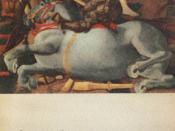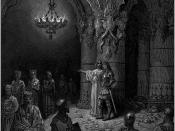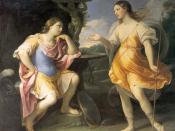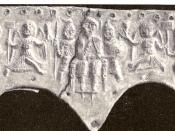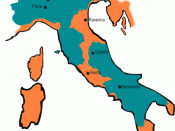The central characters introduced in Italo CalvinoÃÂs novella, The Nonexistent Knight, are curiously diverse, yet each readily identifiable as each are driven or defined by particular quirks. In Agilulf Emo Bertrandin of the Guildivern and of the Others of Corbentraz and Sura, Knight of Selimpia Citeriore and Fez we see order and willpower, in Raimbaut of Roussillon thereÃÂs passion, in the periwinkle female knight Bradamante is desire and pride, in Torrismund a need to belong, and in GurdilooÃÂ nothing, naught but empty thoughts being filled and then emptied on whim. I find, however, that our narrator (and proclaimed writer of this knightly tale), Sister Theodora, personifies a certain idea of her own, she is wishful thinking and the story she weaves (and claims to have been a part of) is wish fulfilment; I posit that this story of hers is all the end result of a restless imagination at work and she is not Bradamante, Bradamante is Sister TheodoraÃÂs insert of herself into her story world.
Our first order of business is clarifying just what I have in mind when mentioning a ÃÂself-insert,ÃÂ or anything of the like. There is a trend among the more enthusiastic fans of various media (especially television, books, comics, and video games) to expand the world of whichever specific title about which they are so passionate, usually fleshing out such worlds through acts of writing their own spins on what happened before, during or after the existing story; this is generally dubbed ÃÂfanfictionÃÂ and this is where the term ÃÂself-insertÃÂ has been coined, though such a device is not exclusive to derivative works, nor is it as recent a phenomenon. Put simply, a self-insert is a character placed within the context of a story that is meant to represent the writer as he or she is or to represent the writer as he or she would like to see himself/herself, something akin to an author surrogate. As IÃÂve written, this technique is hardly a new one, writers as far back as Dante Alighieri have been placing themselves into their stories, but the name for it in terms of wish fulfilment storytelling is rather new.
That aside, from the start of the novella, there has been what I had initially thought to be intentional comedic discrepancies by a neutral third person perspective in the manner CharlemagneÃÂs military operated. Chapter one introduces the paladins of Charlemagne as the emperor himself reviews the company in a lax fashion, chapter two sees the invisible knight, Agilulf, directs young Raimbaut to the Superintendency of Duels, Feuds, and Besmirched Honor (a comically bureaucratic system for conducting vengeance) when the boy asks how he should go about avenging his fallen father (14). Further on, when Torrismund announces that the young woman Agilulf had rescued from rape was not a virgin, a peculiar chivalric practice is addressed: to rescue a noble-birthed virginÃÂs chastity was immediate access to knighthood, but to rescue a noblewoman whose maidenhood was no longer in tact would only earn an inflated pay (78).
Historically, the process of becoming a knight was a long one beginning quite early in youth and required a young man to undergo many stages in his training; he would begin as early as 6 years of age as a page (a waiter or personal servant of a noble) and learn basics in courtesy, polished manners, hunting, weapons, and much more. By fourteen at the earliest, the boy would then become a squire and would be taken under the guidance of (while serving) a knight, and once the squire had honed his skills and learned his lessons well, he would then be dubbed a knight (medieval-life.net). Once the erroneous explanation of knighting is given, however, we already know something integral to the story: in chapter four, the perspective shifts from third person to first as a narrator of sorts reveals herself as Sister Theodora, the writer of this tale, and from there the discrepancies begin to make sense; the tale is written by a cloistered nun, how is she to understand military procedure?Beyond just the absurdities behind some of the happenings in CharlemagneÃÂs assembly of paladins, the title character, Agilulf, is an oddity all his own. He is a knight who does not exist in any physical form but is a thought, or rather, he is thought itself and this disembodied voice and willpower occupy a pristine white suit of armor while in service for the emperor. While we cannot truly prove that a thought cannot be a living form of its own walking about the earth unseen, to portray such an idea as possible is quite a fantastical move and as such lends to the fairytale quality of this narrative. So we have in the character of Agilulf, a heavy element of fantasy, from his lack of physical existence to his perfection in all he does.
Now we come to a definite head-turner in the tale, the proud and beautiful princess-turned-knight, Bradamante. BradamanteÃÂs case isnÃÂt one like that of Jeanne dÃÂArc where she is a woman secretly and merely playing the role of a man, Bradamante is very openly female and is pined after by the paladins of the order. Her sexual exploits are not secret, nor is her nearly impossible true desire in a man and sheÃÂs a master in combat and weaponry; all around, Bradamante stands out blatantly as a woman during a medieval time. While orders of female knights were not entirely unheard of, such occurrences were rare. The Order of the Hatchet is the only female order about which a great deal of information is known, and of the few instances when women were permitted knighthood, this order was the only one whose women saw the combat privileges that male knights received. The Order of the Hatchet was formed in Catalonia by the count of Barcelona in recognition of the women who fought in defense of their town while under attack from the Moors. These women received other knightly privileges besides combat, they received tax exemption and also had precedence over men in public gatherings (hereldica.org), though nothing else was heard of this order beyond the original members, so presumably the order died with the original members. Regardless of this miniscule instance of female knights, this order was formed in the 1100s, while Bradamante would have been in the military sometime in between 768 and 814 AD, as this was the time of CharlemagneÃÂs rule over the Franks making her existence as a knight in real-world possibilities sketchy at best.
It is through the character of Bradamante, however, that my assertion comes together; Sister TheodoraÃÂs tale is just that, a mere tale and not factual recordings as she had seen it. By the time we have reached the novellaÃÂs end at chapter twelve, a complicated journey has reached its end as each character (sans Bradamante and Raimbaut) finds their own resolution. Bradamante has captured the attention and heart of young Raimbaut, but does not return the sentiments, rather she travels the land over in a rather desperate attempt to locate the only man who has ever won her difficult-to-please heart, Agilulf. Bradamante disappears for year upon learning of AgilulfÃÂs collapse and finding Raimbaut in the vanished knightÃÂs white armor, and Raimbaut pursues herÃÂ but what has become of the female knight? Sister Theodora employs a twist in her tale when she reveals herself to be none other than the proud Bradamante, hiding in the abbey for years in mourning for Agilulf and now desiring the love of Raimbaut, who she frantically writes is waiting for her outside the convent.
It is here that I feel BradamanteÃÂs role as Sister TheodoraÃÂs self-insert comes into full play. Theodora says early in the novella that writing is her penance, now at the end she says this tale that has been her task to write was one she experienced for herself and that she still has had many other adventures for which punishment she was tasked to record. IÃÂm certain, however, that the writing punishment for Sister Theodora is along the lines of the philosophy that ÃÂidle hands are the devilÃÂs work.ÃÂ No doubt, she has a colourful imagination and is more than likely prone to daydream, and this coupled with the lack of proper military procedure and TheodoraÃÂs claim as being the talented, fierce, beautiful, and loved princess-come-knight, Bradamante, leaves no doubt in my mind that the story of the Nonexistent Knight told from her narrative was pure fabrication on the good SisterÃÂs behalf.
Works CitedCalvino, Italo. The Nonexistent Knight. Harcourt Brace. 1962"Medieval Life." 2000. 13 Nov. 2007..
Veld, Françoise. ÃÂWomen Knights.à21 Oct. 2005. 13 Nov. 2007.

